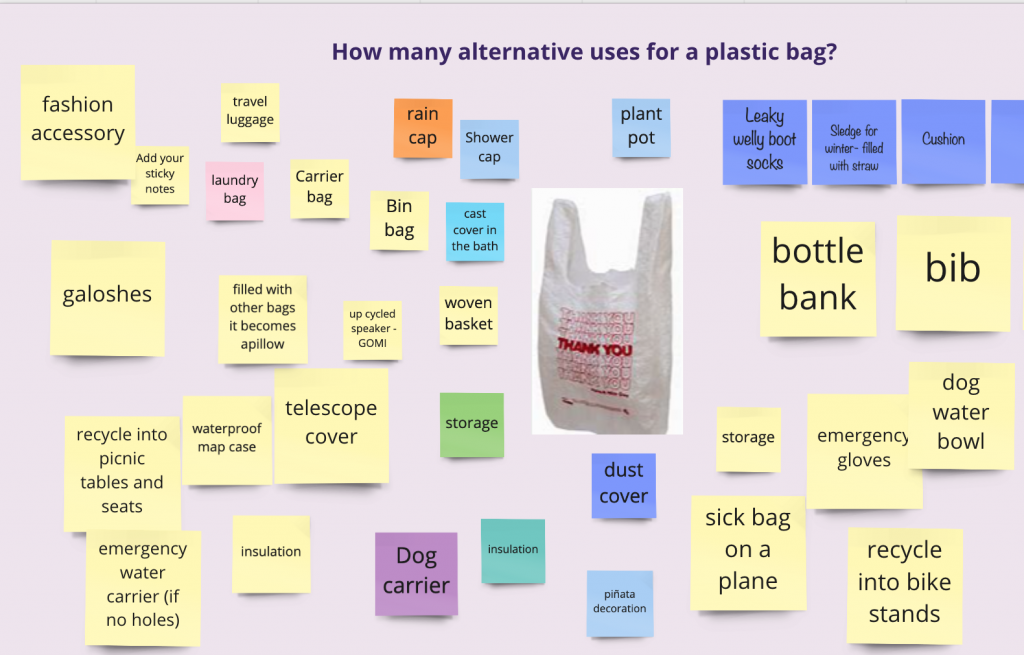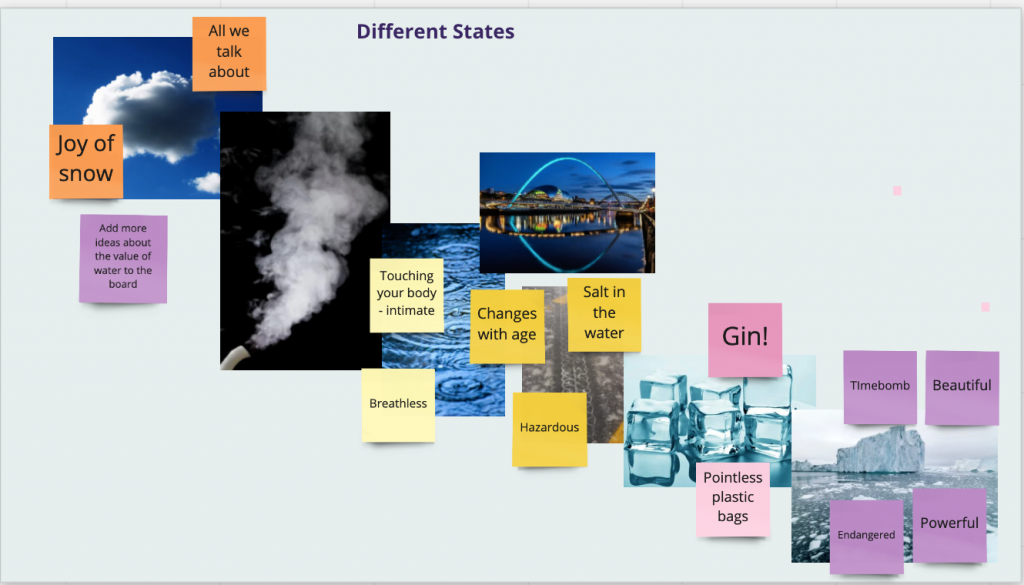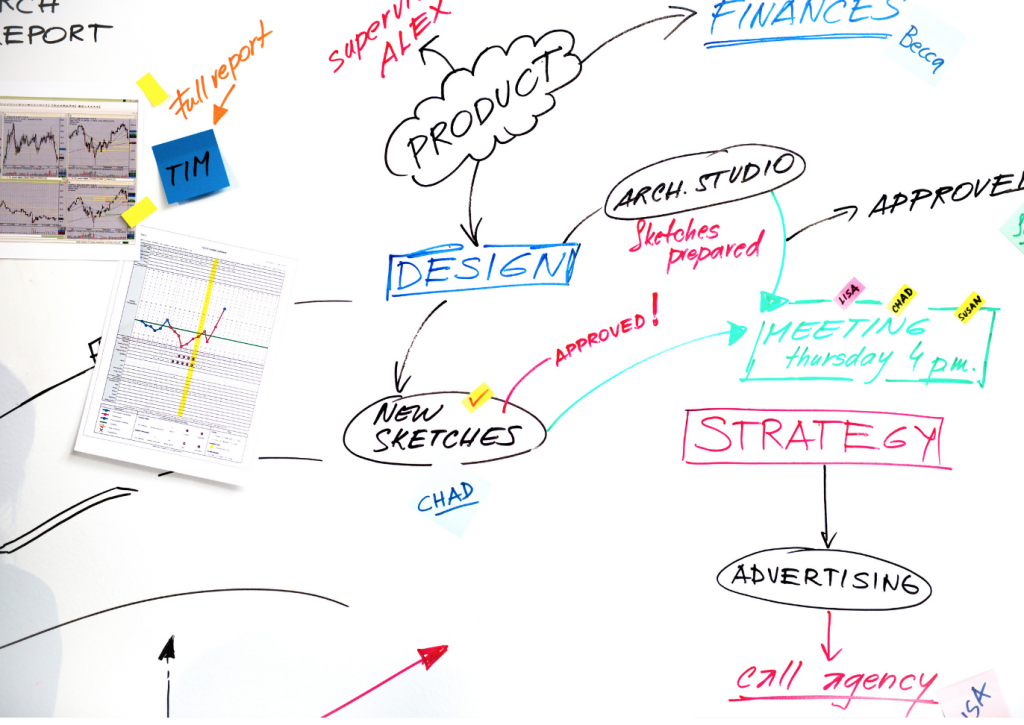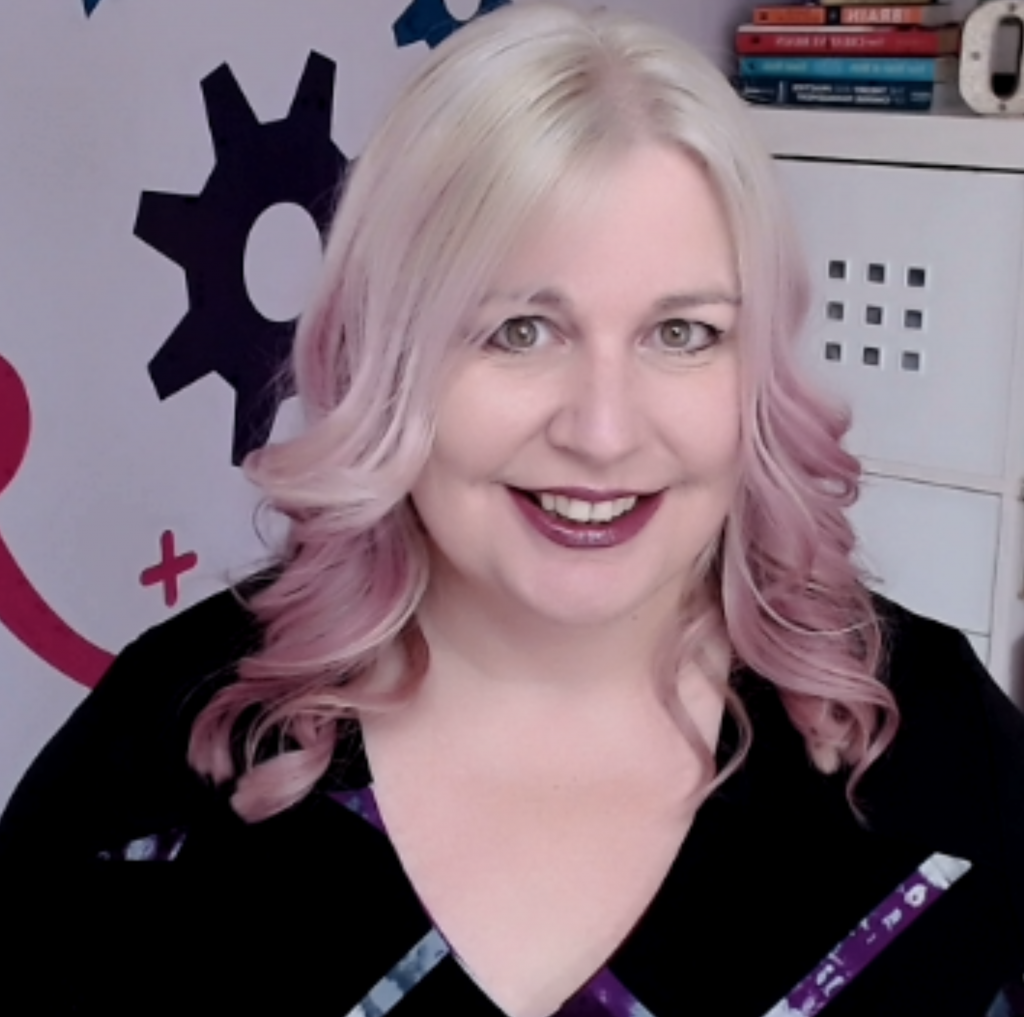Posted in Blog, Boost Your Brainpower, Create, Facilitation, Innovation by Jo North
Being able to get ideas flowing in online meetings is a really important skill for virtual facilitators.
Whether we’re training, leading innovation, design thinking, problem solving or product development sessions, it’s important that we provide the environment, process and tools to help people think creatively and share their ideas so they can bounce off each other.
This article is all about how to get those ideas flowing when you’re facilitating online meetings. But before we really dig into that, I’d like us to start by thinking about what an idea actually is.
What is an Idea?
We use the word idea often, don’t we, but very rarely stop and think about what it means.
An idea is two thoughts that come together for the very first time. It’s an electrical, chemical, physical reaction as your neurons connect different bits of data that you’ve got in your mind to form new connections – and that’s when an idea is born. We literally do have those mini aha, or eureka moments when an idea strikes, which is great.
It can be especially challenging to get ideas flowing in your online meetings, but it doesn’t have to be. With a bit of planning with some creativity, you can get your delegates’ ideas flowing for sure.

Now, the thing is that our minds can get into a bit of a rut. As humans, our brains try and conserve as much energy as possible and our brains try to keep us safe by sticking to what we know. That’s all great, but not particularly helpful when we want to get creative and innovative. Including activities and approaches in your sessions that positively and helpfully disrupt our usual day-to-day work thought patterns is essential.
Create the Right Online Meeting Environment
It’s important to make sure that you set up the right environment for your session and build in an element of purposeful playfulness. There is copious research that shows that having some fun whilst being purposeful really does help stimulate more ideas and greater creativity.
Set the right tone from the very beginning of your session, via great icebreakers and through how you show up, present yourself, get things going and the tone that you set for your session.

‘Premature evaluation kills creativity!’
As you’re facilitating the different activities in your online meeting, make it clear which ones are about idea generation, and which ones are about evaluating ideas, critiquing them or looking for risk or downside, because “premature evaluation kills creativity”. When your participants are in the ideation mode, encourage them to keep the ideas coming even if they’re a bit rubbish, because an idea might take them somewhere completely new and in a different direction. If somebody else builds on it, and they build on it and so on, a not-so-great idea can become something with potential.
Your delegates need to be able to express all their ideas, give them time and life to see where they might lead.
Evaluating, selecting and critiquing ideas need very distinct and separate activities from idea generation. Direct delegates away from criticising ideas as they’re coming out. It’s really like slamming the brakes on ideation.
Now, some really practical tips that you can use to get those ideas flowing when you’re facilitating your online meetings and workshops.
Use Questions
Questions such as ‘what if?’, ‘how might we?’, ‘wouldn’t it be fantastic if..?’ are great questions to get your delegates using because they give permission for people to think differently. They open up possibility.

‘What if…?’ questions are brilliant, particularly if you’re working on strategy, leadership or innovation. You can use it in training situations as well. Examples are:
- What if your biggest competitor closed down? How would you make the most of that opportunity?
- What if a big competitor opened up right next door? How would you tackle that?
Idea Generators for Online Meetings
Another really good way of getting your delegates’ ideas flowing in your online meetings is to be creative with the idea generators that you use.
I use words, pictures, numbers, physical objects, movement and sound in different ways in virtual workshops as well as in person sessions to get people thinking differently and stimulate different parts of the brain. Using these techniques relaxes people, helps them to have fun so that they engage and get those ideas flowing.
Here are some examples.
Random Stimulus, or Force Fitting
A great activity is to invite people to find a random object and then write down 10-12 interesting words to describe that object, working in small groups. Then ask the groups to convert each of those words into potential ideas for whatever your delegates are working on in the session. This activity is called random stimulus, or force-fitting, because the purpose is to ‘force fit’ an idea from one place into being a solution for another. If you haven’t tried it before it does look weird on paper, admittedly, but it works brilliantly in practice and is a fantastic post lunch or morning warm up activity, too.

Random Pages
Ask delegates to grab the book, magazine or newspaper nearest to them, open it at a random page and find at least one idea on that page that could lead to a solution – however far-fetched- for the challenge in hand and then share that idea back.
Words and Music
You could give breakout groups different random words to use and play around with to stimulate ideas, and distribute those words randomly as well.
Or you could play different songs or types of music and ask your delegates to come up with ideas triggered by what they hear.
Get Everyone Moving
If creativity feels like it’s stagnating a little, get people moving around, just having some mini-breaks where maybe you do some office yoga can make all the difference.
Sometimes I’ll facilitate some gentle, safe stretches and breathing exercises for 2-3 minutes with delegates to re-energise them. Physical movement helps the brain to work.
Numbers
One of the things I really like to do when I’m virtually facilitating online meetings is to use a dice roller (just Google online dice). With a click of a mouse, delegates can roll a dice online, get a number, and use the number as a prompt for idea generation.
Pictures
When we work with pictures and visual imagery we light up different parts of our brain. Getting delegates to find images online and maybe using collaborative whiteboard tools like VWall, Milanote or Miro are great for creating vision boards and story boards.
You can also use virtual canvases that feature imagery and colours for your delegates to use in breakout sessions.
Design your Online Meetings for Different Thinking Styles
Recognise that different people have different thinking styles. Some people have ideas better when they’re reflecting internally, and they’ve got time to process for themselves. They get their ideas from within themselves.
Other people get ideas from speaking to others and bouncing thoughts around in conversation.
It’s important to accommodate both of those.
Sometimes in the session, I will ask delegates to turn off their cameras and mic and work alone for a few minutes and then bring people together to share their thinking.
Check out my Idea Time book, available on Kindle for £5.99, for even more great ideas.
Crazy Eights
A creative technique that you could use in your virtual facilitation is ‘Crazy Eights‘. If you haven’t come across it, it’s in the Google ‘Sprint’ book by Jake Knapp.
Ask delegates to work individually and get a piece of A4 paper and a pen, fold their paper so that it comes out with eight squares and create an idea in every square using a sketch and / or words. They have a timed minute for each idea, so 8 x 1 minute sessions (that’s why it’s called Crazy Eights). So everybody will work on the first square for a minute, then the second, then the third, then the fourth, fifth, sixth, seventh, and eighth. And of course, the further they go, the harder it gets – and some some really good stuff comes out of the stretch!
Once the 8 minutes are up, in breakout rooms delegates put their Crazy Eights ideas together to create a single shared solution. This is called a ‘solution sketch‘.

Pairs and Small Groups
Using pair and small group working with activities such as co-consulting, in which people will share their challenges and then listen to their colleagues’ thoughts and ideas on that challenge can be really effective for getting ideas flowing because you’re tapping into our human desire to help others and share our expertise and ideas.
Design your online meetings to have a balanced blend of people working individually, people working in pairs, fours, and as an entire group to keep the energy flowing. It’s stimulating for your delegates and it suits different thinking styles as well.

Getting better ideas in your online meetings
Don’t forget that we need to have loads of ideas to have a few great ones. Ideas often are a numbers game, especially when we’re having ideas in a business context.
The more ideas your delegate have, the better, because the first batch of ideas are usually the most obvious. We need to get those out of the way and start stretching ourselves, building on those and playing around with them in order to get to something great.
Please do give people time to have great ideas. I see so many facilitators, just shut things down far too early. People have had some ideas but nothing that’s particularly different or spectacularly special because the facilitator hasn’t allowed them the time or process to enable those ideas to develop into something a little bit more innovative.
Often I’ll use several idea generation techniques in succession to really, really push and stretch that thinking.
Next Steps
I hope that’s been really helpful for you. Let me know what tools and techniques and approaches you’re using to get those ideas flowing, because I know you’re using lots of great stuff as well.
If you haven’t joined already, you’re very welcome to be part of my free private Facebook Group, Idea Time for Workshop Facilitators. Why not check it out and join – just click on the button here.

